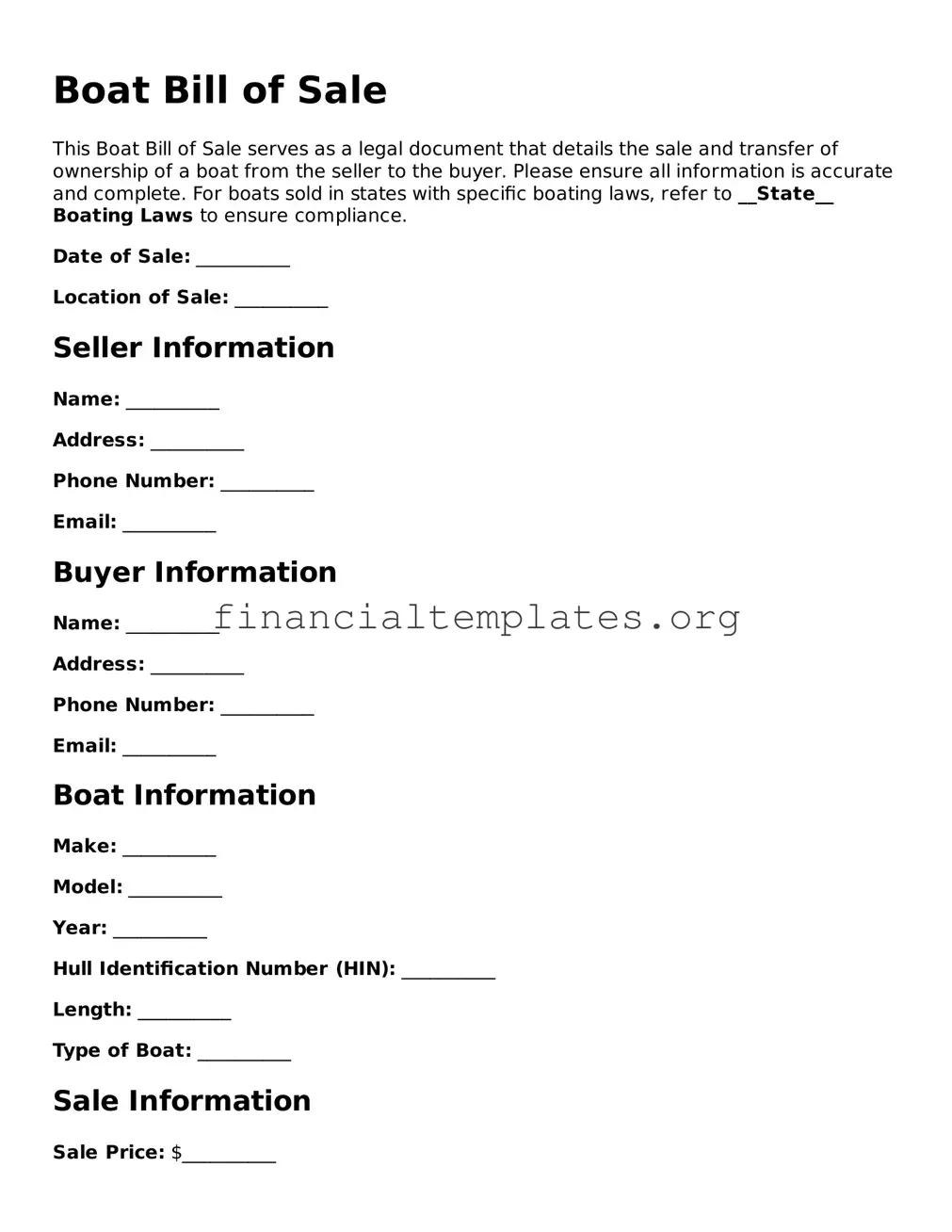A Boat Bill of Sale form is similar to a Vehicle Bill of Sale in that both serve as legal documents providing proof of purchase and change of ownership. Typically, they detail the seller's and buyer's information, describe the item being sold, including make, model, and year, and note the sale price and date. Each ensures a formal record of the transaction, crucial for registration and taxation purposes.
Like a Real Estate Bill of Sale, a Boat Bill of Sale provides evidence of a transaction, albeit for different types of assets. While the former pertains to property and land, the latter deals with the sale of a watercraft. Both documents are legally binding and include specifics about the asset sold, identification of buyer and seller, sale price, and date of transaction. Their purpose is to formalize the shift of ownership in legal and tax records.
A Boat Bill of Sale shares similarities with a Warranty Deed in that both grant assurance regarding the condition or title of the item or property being sold. However, while a Boat Bill of Sale focuses on the transfer of ownership of a watercraft, a Warranty Deed is used in real estate transactions to guarantee that the property is free from liens or claims. Both provide legal protection to the buyer, affirming the seller's right to sell the asset.
Comparable to a Promissory Note, a Boat Bill of Sale might also outline terms of payment if the purchase does not involve a single immediate transaction. This document serves as a record of the item sold and the agreement terms, similar to how a Promissory Note details the amount owed, interest rate, repayment schedule, and what happens in case of default. Both ensure there's a legal record detailing the financial aspects of a transaction.
The General Bill of Sale and a Boat Bill of Sale are alike in that they document the sale of personal property. While the General Bill of Sale can apply to various items (e.g., electronics, equipment), a Boat Bill specifically focuses on watercraft transactions. Each includes information on the buyer and seller, a description of the item sold, the sale price, and the date, serving as evidence of the transaction and transfer of ownership.
A Receipt is another document that resembles a Boat Bill of Sale but is generally less detailed and more often used for smaller transactions. However, both serve as proof of purchase, indicating that a transaction has occurred, and they provide essential information like the date of sale, buyer and seller details, and the amount paid. For higher-value items like boats, a detailed bill of sale also includes specifications of the item sold.
Likewise, an Equipment Bill of Sale is akin to a Boat Bill of Sale, with a focused purpose for a specific type of items - in this case, equipment. Both documents finalize the sale process by recording important information about the sale, including a description of the item (e.g., serial number, make, model), the sale price, and the parties involved, thereby safeguarding both the buyer and the seller's interests post-transaction.
The Stock Certificate is a financial document that, while distinct in its purpose, shares a correlation with the Boat Bill of Sale in its evidentiary role. It certifies ownership of shares in a corporation, offering proof of stakeholding, parallel to how a Boat Bill of Sale evidences ownership of a physical asset. Both are pivotal in asserting rights - whether in a corporate entity or over a tangible asset like a boat.
Comparably, a Pet Bill of Sale is used in transactions involving animals, ensuring that the details of the sale — including the date, buyer and seller information, and specifics about the pet (e.g., breed, age) — are formally recorded. Like a Boat Bill of Sale, this document underscores the transaction's specifics and shifts ownership, tailored to the item or being sold. It's a testament to the diversity and specificity of bills of sale, depending on the transaction's nature.
Lastly, an Artwork Bill of Sale parallels a Boat Bill of Sale in its function of transferring ownership of valuable property — in this instance, artwork. Both documents detail the transaction, providing a thorough description of the item sold, along with buyer and seller information, sale price, and date. These details are crucial for insurance, taxation, and provenance purposes, underscoring the document's significance in formalizing the ownership transfer of high-value assets.
